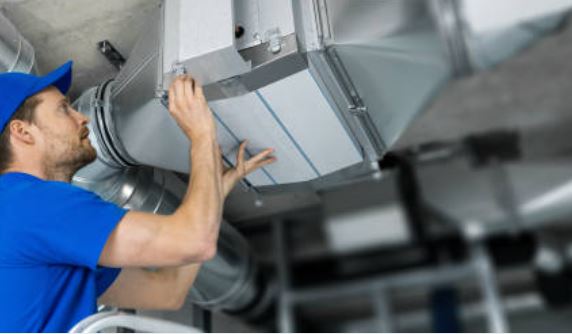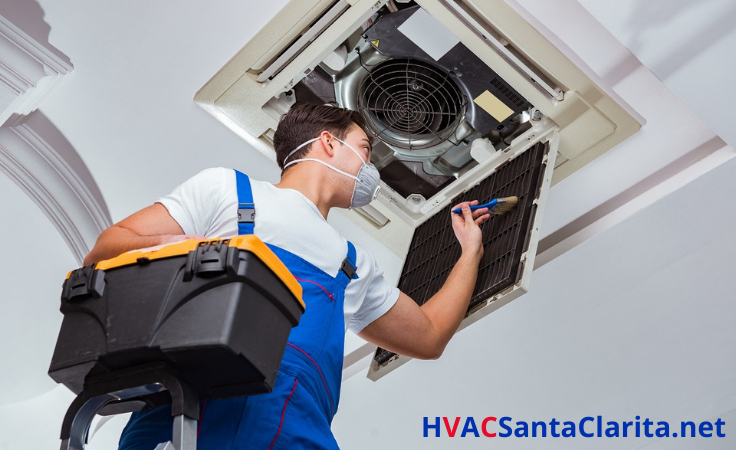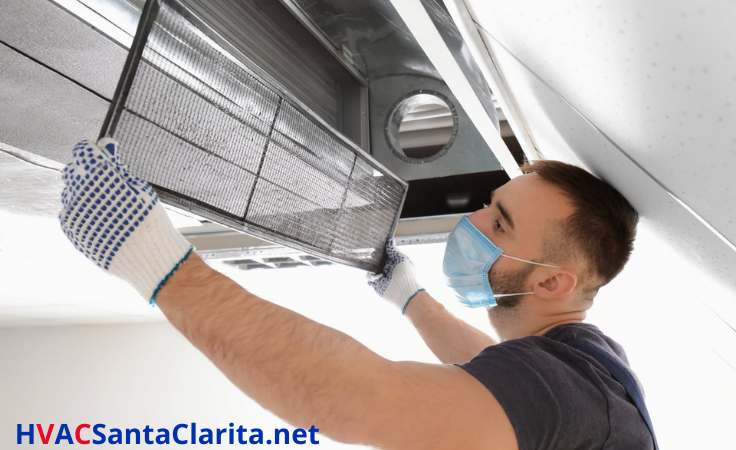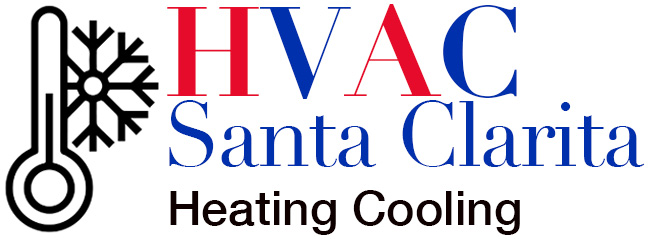An AC maintenance checklist will help ensure you give your AC unit top-notch treatment to avoid AC repairs in the future
To be honest, HVAC maintenance can be a handful. There are a lot of things to watch out for. Some you can do on your own, and some need professional HVAC maintenance. With this, it is super-easy to forget some essential maintenance aspects.
But how do you ensure that everything is taken care of? How do you not forget something behind?
How do you ensure every part is well taken care of?
By having a comprehensive air conditioning maintenance checklist. Looking for one? Worry no more. We have compiled a comprehensive HVAC maintenance checklist for you below.
Let’s get straight in.

call 661-888-0248
Contact 24/7 our scheduling department today to make an appointment.
Ultimate AC Maintenance checklist
This list is not just to help you remember all the parts in your routine maintenance. At HVAC Santa Clarita, we are super keen on details of air conditioning services. We, therefore, go a step further and explain to you how the maintenance activity (1) should be done.
After you have your AC installed, proper maintenance and support will extend the life of your HVAC system .
Let’s go!
AC Filter Maintenance

As a homeowner, the most straightforward maintenance routine you should do for your air conditioning unit is air filter maintenance.
Air filter maintenance is simple. Many filters are disposable. Therefore, your task will be to remove the old filters and replace them with new ones.
The main issue is, after how long should you replace air filters? At HVAC Santa Clarita, we recommend that you do it once every three months.
But, this may also depend on what type of filters you use. If you use non-pleated and thinner air filters, like fiberglass or plastic filters, you need to change filters monthly.
Also, these factors call for frequent changes:
- living in a dusty area,
- pets in the house,
- allergies.
How to Change Air Filters
How do I change my air filters? This is a popular query we get from many homeowners as well as how to clean clogged air filter of ac.
Follow the following steps:
- First, switch off your HVAC system.
- Secondly, open the filter access panel. This is on your air handler.
- Then, carefully remove the filter. Do this carefully to ensure no debris or dust falls off into the system.
- Next, dispose of the old filter. Then, take the new filter and locate the front and back. This will ensure you get the right direction. Some of them come with arrows that indicate the direction of airflow. The arrow must point to the direction of airflow towards the fan.
AC Evaporator and Condenser Coil Maintenance

The second step should be to inspect the evaporator and the condenser unit.
First, you need to keep a close eye on any damages your coils could be having. Check if there could be anything that will inhibit their performance. For instance, if the coil has a hole or crack, that means that the refrigerant may leak out.
How do you clean your condenser coil? If it is a condenser unit on the outdoor unit, you can spray it using your garden hose. Outdoor units are usually more resistant and can handle getting wet.
However, if your condenser coil has grime or dirt accumulation, we recommend using an AC unit cleaning solution.
Cleaning the Evaporator Coil
If you change your filters as needed, you may not have to worry about cleaning the evaporator coil often. We, however, give you the procedure right below for you have to clean it.
First, you should be more careful with cleaning the evaporator coil. This is because it is usually located in a tighter space. Therefore, cleaning it can get other parts of your AC unit wet. You, therefore, have to be super cautious when spraying on your evaporator coil.
As you clean your evaporator, be sure to check out the fins of your AC evaporator and condenser coil. The fins help in the transfer of heat. If any fins are bent or broken, they will lower efficiency. And, this translates to high electricity bills.
So, how do you fix the bent fins? Use a fin comb to reshape the bent fins.
AC Drain Line and Drain Pan Maintenance

Your drain pan and drain line should be clean at all times. Them being dirty may not directly affect the performance of your AC. It may, however, spill to other parts of the AC.
Start by inspecting the parts of the AC drain line and drain pan. Look out for any signs of slime and gunk accumulation.
The presence of organic materials will gradually coat the drain lines. At first, this may not be a problem at all. However, if you allow it to build up, your drain pan will clog, and your drain pan will overflow.
How do you clean your AC drain pan? First, remove any water or debris standing on it. You can use a rag or a wet/dry vacuum to suck the water. Remember that the drain pan should not have water in it. If your drain pan has a lot of water, it may indicate clogging in your drain line.
Cleaning the Drain Line
To clean the drain line:
- Scrub its interior using a flexible drain brush.
- Start from the outside of the house and insert the brush inside the pipe where your AC drain is.
- Use the soft brush to scrub in circular motions.
Next, remove the vent cap on the vent tee from the inside of the air handler. Gently scrub the interior of the drain line from the vent tee opening to the drain line. IN the process, you can unclog any blockages.
Then, create a 1:1 bleach mixture. Pour this mixture down your vent tee opening. This mixture will help kill slimy algae that generally grow in the AC drain line. Also, the bleach will help prevent the future growth of algae.
Sometimes, you may not fit the drain brush inside the drain line. This is usually because it is usually wholly clogged. The best option would be to use a wet/dry vacuum to suck the debris. You may use duct tape to firmly secure the vacuum hose to the drain line. This will ensure it forms a good seal before sucking the slime out.
Again, you will meet stubborn clogs that a vacuum cleaner will not suck out. In these cases, a drain gun could help out. A drain gun inserts pressurized gas into the drain line. We, however, recommend this as a last resort for drain lines that are completely clogged.
AC blower and Fan maintenance

The blower is a centrifugal fan in your air conditioner that blows out large amounts of air throughout your house. You see, it is a critical part of your air conditioning system from this. This means that you should be keen on maintaining it.
To maintain it, first, turn off your HVAC system. Then, open the air handler’s access the panel and visually inspect the motor and fan. Ensure that the fan is free from debris and dust.
Also, check out that the motor and fan are rotating freely. The motor should not move to vibrate from its fixed position. Inspect the pulleys and fan belts in your unit. Ensure that your belt is in good condition and not worn out. Plan to change overworn belts. We, however, recommend that you change belts once a year. However, the lifespan of your belt will depend mainly on how it is tensioned and aligned. A properly aligned belt can last longer than a year. On the other hand, a poorly aligned one can last only a few weeks.
AC Fan Motor Oil & Lubrication

You have to regularly lubricate the moving parts of your air conditioning units. Lubricating the fan motor is essential, especially for the AC condenser fan motors. Since the condensers are located outside, they are more susceptible to dirt, debris and rain. For this reason, you need to put it in working condition. And this is by regularly oiling it.
Does your condenser make a high-pitched screeching noise? If yes, it is crying for lubrication oil.
Lubricating the Condenser Fan Motor
First, switch off the power to the condenser unit. Then, remove the screws from the top of the unit. This will enable you to remove the panel and finally access the fan motor. Next, use an applicator tube or syringe to deliver oil into the ports of the fan motor.
The oil ports are small holes inside the fan motors. They are usually sometimes hard to find. You, therefore, have to look more keenly.
Remember to lubricate the motor shaft too.
AC Electrical and Controls Maintenance

We often recommend that you leave the electrical maintenance and electrical components to HVAC professionals most of the time.
There are, however, some services you can perform to lower your utility bills or avoid costly repairs. This is mainly to ensure that everything is running smoothly.
Read on for the most straightforward electrical air conditioning maintenance you need to perform on your unit.
First, start by powering your entire system. This applies to both outdoor and indoor units. Then, remove the panel that houses the unit’s electrical controls. Look but for any signs of loose wires or corrosion. Loose connections can cause fire or sparks. Therefore, ensure that all connections are intact and tight.
You can perform a cleaning in your regular maintenance, a simple and safe operation. Get your air compressor and blow off the dust, dead insects and other debris from the electrical enclosure. This is a way to prevent fires and electrical failures.
Check your thermostat for proper operation
Do you have a variable speed fan? If yes, you need to ensure that all fan speeds are working correctly. Check this by ensuring the temperature reading on the thermostat corresponds to that of the portable temperature sensor.
Besides, you need to check for the functioning of the modulating dampers and valves. The dampers and valves should open and close quickly. This is because the thermostat controls them. If they are not opening freely, the thermostat could be a problem. And that means that you need to contact an HVAC technician.
We invite you to contact us as HVAC Santa Clarita to troubleshoot any electrical issues.
Ductwork Inspection and Maintenance

Ductwork is believed to be the simplest to maintain. It, however, comes with its issues. The ductwork delivers air from the AC unit to other house parts. You, therefore, have to ensure that it is working effectively.
Start by checking the vent for any signs of mold or dust accumulation. A little dust is regular, but a build-up would cause you trouble. You can use either a cloth or a soft brush to clear dust build-up.
Also, be sure to inspect for small insects or animals that may be stuck. When they die in the ductwork, they create a smelly mess that eventually affects air delivery.
Besides, you need to check out for any signs of corrosion. Corrosion could cause leakage of air. Air leaks from the ductwork will reduce the efficiency of the air conditioning process.
Cleaning Mold from Ductwork
First, you need to wear protective wear when cleaning off the mold. Breathing in mold spores is dangerous. You, therefore, need to be keen while cleaning up. Always have on:
- Nose and mouth mask,
- gloves,
- glasses.
Then, use a utility brush to scrape off the mold from the vents. Ensure that the brush moves between the tight slots to scrap the dirt and mold. Then, you can use a soft scrubber or a sponge. You can use a light detergent to clean thoroughly.
We also recommend using a disinfectant to prevent the future growth of molds.
Professional AC Maintenance Santa Clarita

Well, with a car, you can do many maintenance practices on your own. But, for some servicing, you need to call a professional. It could either be due to safety hazards or insufficient knowledge in the servicing process.
This is the same with AC maintenance. Here are some of the popular maintenance practices you will need to contact an HVAC technician for:
- Measuring amperage and voltage of blower motor for proper operation
- testing for proper operation, calibration and level of the motor
- Bearing – inspect for wear and lubricate
- Inspection of indoor coil
- Monitor operating pressures with refrigerant
- Inspect for proper rating and safe installation of the electrical disconnect box
- Electrical Wiring – inspect and tighten connections
- Inspection of contactors for burned, pitted contacts
- Check for exposed wires
- Inspect and test capacitors
- Replacement of fan blades
- Clean condenser coil and remove debris
- Inspect service valves for proper operation
- Measure Supply/Return temperature differential
- Inspect ductwork for energy loss
- Monitoring, measuring amperage and volt draw and wiring connections of contractor
Have a professional HVAC technician perform these maintenance services to your system at least once or twice a year.
AC Maintenance Checklist Frequently Asked Questions

Here are a few AC maintenance FAQs. We hope that these will help you answer any AC maintenance (2) queries you could be having.
What does AC Maintenance Consist of?
There is a lot involved in HVAC maintenance. but to give what the process involves:
- cleaning of debris and dust from parts such as the coil,
- replacing of worn-out parts such as filters,
- lubricating moving parts,
- checking on the functioning of the thermostat,
- inspecting and rectifying corrosion the ductwork
- ensuring tight wire connection.
How often should you do maintenance on your AC?
You can have professional maintenance once or twice a year. You, however, need to perform your DIY HVAC maintenance at least once a month.
What is AC preventative maintenance?
This is the maintenance of your cooling system to prevent failures, breakdowns or fires. It is often more expensive to repair when such problems happen. And all these can be prevented by regularly maintaining and servicing your air conditioning system.
Final Thoughts

As Ezra Taft Benson said, “It is better to prepare and prevent than it is to repair and repent,” we suggest that you go stronger on your AC maintenance. You don’t want to sit back and watch your AC unit deteriorate. You also want to service it regularly to prolong its lifespan and make its functioning optimum.
There are a lot of maintenance practices you can do. However, when it is time to schedule a professional HVAC maintenance, do not hesitate to contact HVAC Santa Clarita. We then will ensure your AC gets all the professional HVAC maintenance it needs.

call 661-888-0248
Contact 24/7 our scheduling department today to make an appointment.
Our Address is
HVAC Santa Clarita
26893 Bouquet Canyon Rd
Santa Clarita CA 91350
Opening hours
Monday 8 am – 8 pm
Tuesday 8 am – 8 pm
Wednesday 8 am – 8 pm
Thursday 8 am – 8 pm
Friday 8 am – 8 pm
Saturday 8 am – 8 pm
Sunday 9 am – 5 pm
Also, read
